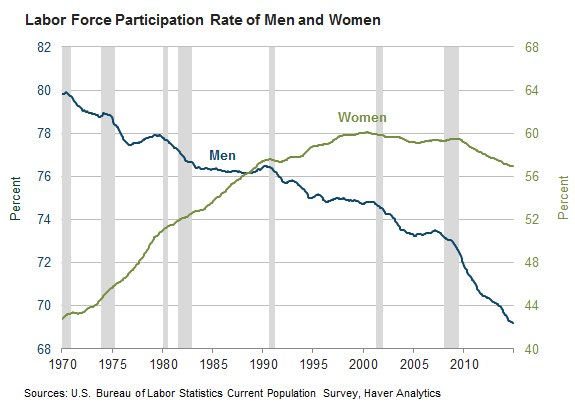CHART OF THE DAY: Trends in Labor Force Participation
It's been ages since I broke off a CHART OF THE DAY post and even longer since I talked about the Labor Force Participation Rate, so let's remedy both of these situations in one shot.
Courtesy of your pals at the Federal Reserve Bank of Atlanta, have a look at a recently published chart on participation, this one broken down by gender. As always, some insightful comments from me after the data:

Let's break down the data a little, and see if we might (Shock!) learn something. Some observations...
1. Male labor force participation has been on a long and steady decline for ages. In fact, males, as a group, have been less and less inclined to participate in the labor market since at least World War II.
2. The female participation rate increased from about 43 percent in 1970 to a peak of 60 percent in the late 1990s, from which it has remained relatively flat over the last 15 - 20 years.
3. But despite the economic recession of 2007 - 2008 ending, the data show that between 2010 and 2013, participation declined even more steeply for both men and women. Average female participation in 2014 was 57 percent—the lowest level since 1988—and male participation was down to a record low of 69 percent.
What should we think about when considering this data? After all, participation is influenced by numerous factors like workforce age, prospects, disability rates, desire to continue schooling, etc.
Let's look at what the Atlanta Fed thinks is the near-term direction for Labor Force Participation:
"As a guide, the Bureau of Labor Statistics projects that the factors pulling down the labor force participation rate will outweigh those pushing it up, and that by 2022, labor force participation will be 61.6 percent, 1.4 points below its level at the end of 2014."
The trends and the predicted continuation of these trends suggest a labor market that is even tighter than we are experiencing currently. It seems also likely that the kinds of jobs that will be hardest to fill are not the ones that will be easily filled by simply coaxing more people back into the labor force.
If anything, a declining participation rate makes even seemingly 'easy' to fill jobs that much harder to fill.
Long story short, this data suggests that filling all kinds of jobs is just going to get tougher. It's probably a good time to be a recruiter though.
A good recruiter I mean.

 Steve
Steve
Reader Comments (1)
This is one of the most incredible article I've read in a really long time. I hope you update this blog often because I’m anxious to read more about.